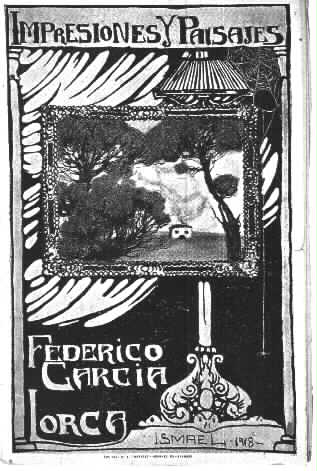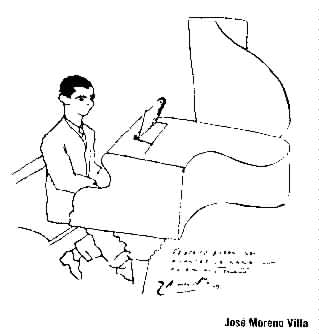PROSE
 During
his lifetime, Lorca only had one book of prose published: Impresiones
y Paisajes (Impressions and Landscapes). The book was published in
1918 by the P.V.Traveset Press in Granada. It was the fruit of a series
of study tours throughout Spain that Lorca undertook under the guidance
of Don Martín Domínguez Berrueta, Professor of Art History
at the University of Granada. The collection of prose descriptions
and impressions came as a surprise to even his closest friends who, until
then, had considered Lorca a budding musician.
During
his lifetime, Lorca only had one book of prose published: Impresiones
y Paisajes (Impressions and Landscapes). The book was published in
1918 by the P.V.Traveset Press in Granada. It was the fruit of a series
of study tours throughout Spain that Lorca undertook under the guidance
of Don Martín Domínguez Berrueta, Professor of Art History
at the University of Granada. The collection of prose descriptions
and impressions came as a surprise to even his closest friends who, until
then, had considered Lorca a budding musician.
The cover was designed by the local artist Ismael González de
la Serna, a good friend of Lorca's.
Interested in buying this work?
Click: Impressions
and Landscapes
Though Lorca, as a creative artist, never returned
consciously to the medium of prose, he did leave a large body of "incidental
writing" which comes under that category. This body of writing includes
lectures and talks and commented poetry readings, speeches and homages,
personal correspondence and interviews. Much of this writing is of great
literary value in itself, while giving invaluable insights into the esthetic
ideas, creative process and private life of the poet, not easily accessible
in the poetic and dramatic writing.
A unique piece of creative prose writing is to
be found in the "legend" Historia de este gallo (The Story of this Cock)
that Lorca wrote for the first issue of the local Granada literary magazine
gallo which he finally launched in February 1928. This work
suggests that imaginative short story writing could have become another
facet of the poet's wide range of creative self-expression, had he lived
to develop it.
Lorca's correspondence is a veritable goldmine
of Lorquian literary images and originality and reveal at the same time
much fascinating biographical detail.
You might be interested in either
of the following editions:
Selected
Letters (Hardback)
Selected
Letters (Paperback)
Of the homages and speeches, outstanding is the
Alocución al pueblo de Fuente Vaqueros (Allocution to his natal
village of Fuente Vaqueros), an elogy to the Vega of Granada, the extensive,
Genil River valley plain that was a never-ending source of inspiration
and material for his poetic and theatrical works.
It is worth pointing out that all of Lorca's orally
delivered pieces were previously written down and he never appeared in
public to give a talk or make a speech without a piece of paper in his
hand. He rarely needed to refer to and he often deviated from the
written version, which he would then amend from delivery to delivery. The
following is a list of talks and lectures with the date of their first
"performance":
-
Arquitectura del Cante jondo (Architecture
of the Deep Song)
This talk was first given at the
Centro Artístico de Granada under the title La importancia
histórica y artística del primitivo canto andaluz llamado
"cante jondo" (The Historical and Artistic Importance of the Primitive
Angalusian song known as "Deep Song") , on 19 February 1922 as part
of the preparations made by the Centro Artístico for the
Deep Song Competition held at the Alhambra in June that same year. In New
York he made amendments and corrections to the talk for its delivery in
the spring of 1930 in La Habana, Cuba. It was repeated on many occasions,
illustrated with gramophone recordings, during the years of the Second
Republic.
Deep
Song and other Prose can be purchased by following this link.
-
La Imágen Poética
de Don Luis de Góngora (The Poetic Image of Don Luis de Góngora)
First given on 13 February 1926
at the Centro Artístico in Granada as part of the preparations
for the celebration of the Third Centenery of the baroque poet's birth
the following year. In later versions (La Habana and later), the enthusiasm
for gongorism and cubism of the original version was toned down.
-
Paraíso cerrado para muchos,
Jardines abiertos para pocos (Paradise closed to the many, Gardens open
to the few)
This talk about Granada's own baroque
poet, Pedro de Rojas, and the city's traditional type of dwelling called
the carmen was given in Granada on 17 October 1926.
A
Season in Granada. This book includes the essay on Pedro de Rojas and
other pieces of prose and poetry on themes related to Granada.
-
Imaginación, Inspiración,
Evasión
This same talk was later reworked
and given in New york under the title of Tres modos de poesía
(Three kinds of poetry) and in Cuba with the title La mecánica
de la poesía (The Mechanics of Poetry). Here Lorca, very much
under the influence of Salvador Dalí, expounds his theory of the
creative artistic process. Lorca delivered the lecture on 11 October 1928
at the founding meeting of the Ateneo of Granada, set up by the
same group that had pdrouced the magazine gallo earlier in the year.
Two weeks later, on 27 October 1928, at the same venue, Lorca gave a talk
entitled "Sketch" de la nueva pintura (Sketch of the New Painting)
in which he elogises the young Dalí as natural successor to Picasso,
Juan Gris and Miró.
-
Canciones de cuna españoles
(Spanish lullabies)
 Performing the lullaby "La Nana"
Performing the lullaby "La Nana"
Lorca's contention was that through
lullabies and other forms of folklore, middle-class children like himself
were introduced to the rich popular cultural tradition of Spain. Lorca
delved into this popular tradition and made it his own. This talk was first
given at the Residencia de Estudiantes in Madrid, where he himself
was a resident during the 20s, on 13 December 1928.
-
Como canta una ciudad de noviembre
a noviembre (How a City sings from November to November
Taking up the theme of popular
tradition again, and also the Granada theme from Paraíso cerrado,
the origins of this talk are to be found in a recital by La Argentinita,
accompanied at the piano by the poet, of the city's popular seasonal
songs, given in Madrid in April or May 1933. He repeated it in Buenos Aires
on 20 October of the same year, this time interpreting the songs himself
to his own piano accompaniment.
How
a City Sings from november to November can be bought following this
link.
-
Juego y teoría del duende
(Play and Theory of Duende)
Lorca was finishing this new version
of his view of artistic creativity on his way by boat to Argentina, where
it was first delivered in Buenos Aires on 20 October 1933, a week after
his arrival. This is perhaps Lorca's most famous prose piece and his most
original contribution to the theory of artistic creativity. It replaces
Imaginación, Inspiación, Evasión and builds
on his earlier developed Arquitectura del Cante Jondo as well as
on his commentaries to the public readings of Poeta en Nueva York.
In
Search of Duende includes this work and other passages of prose in
which Lorca makes reference to his theory of duende.
The interviews that Lorca gave to the press give
more evidence of the poet's eloquence, startling imagery and flights of
fancy while revealing important facets of his life and personality. As
an example, I would like to mention here only the Diálogos de
un caricaturista salvaje, the interview he gave to the "wild charicaturist
Luis Bagaría which appeared in El Sol newspaper on 10 June
1936.
Although the interview has a very spontaneous
and colloquial effect, the questions were given to Lorca in writing, to
which he then wrote his considered replies. So there can be no question
of Lorca "talking off the top of his head". The interview reveals Lorca
deeply committed to political democracy, economic equality and complete
freedom of expression - in a word, to the most radical aims of Second Republic,
already seriously under threat from fascism, barbary and reaction.
Return to
Home Page
 Performing the lullaby "La Nana"
Performing the lullaby "La Nana" During
his lifetime, Lorca only had one book of prose published: Impresiones
y Paisajes (Impressions and Landscapes). The book was published in
1918 by the P.V.Traveset Press in Granada. It was the fruit of a series
of study tours throughout Spain that Lorca undertook under the guidance
of Don Martín Domínguez Berrueta, Professor of Art History
at the University of Granada. The collection of prose descriptions
and impressions came as a surprise to even his closest friends who, until
then, had considered Lorca a budding musician.
During
his lifetime, Lorca only had one book of prose published: Impresiones
y Paisajes (Impressions and Landscapes). The book was published in
1918 by the P.V.Traveset Press in Granada. It was the fruit of a series
of study tours throughout Spain that Lorca undertook under the guidance
of Don Martín Domínguez Berrueta, Professor of Art History
at the University of Granada. The collection of prose descriptions
and impressions came as a surprise to even his closest friends who, until
then, had considered Lorca a budding musician.